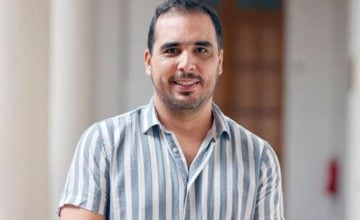A controversial cosmetic surgery is going viral in men who do not feel sure of themselves with their body and so, they transform it.
«Women generally don’t date men who are shorter than them. Sometimes, the hardest thing was feeling like I wasn’t going to find a wife».
The phrase is from Sam, a 30-year-old British man who is part of a trend of cosmetic surgeries for men in countries like the United States, the United Kingdom and even Spain: leg lengthening to increase height.
An invasive operation that involves breaking the femur in order to gain a few centimeters.
Sam points out that, thanks to this operation, he gained 8 centimeters in height and went from being 1.62 meters to 1.70 meters in a few months.
«I’ve always thought that being tall and being successful are related. So I had to find my own solution», he told BBC journalist Tom Brada.
This operation involves weeks of convalescence and a recovery process during which the patient cannot even walk for months.
But not only that, in some cases men pay close to US$70,000 to gain a few inches in height.
«It is a painful operation, which implies a long recovery process because a part of the bone is soft, so you must wait to walk until that bone can support the weight of the body again», said surgeon Kevin Debiparshad, who performs this operation, to BBC Mundo.
Debiparshad has been performing up to 50 such surgeries a month at his Las Vegas practice, called the LimbplastX Institute, where he says he has noticed an increase in demand among male patients.
“Increasingly, the taboo that men do not perform cosmetic surgeries has been left behind. And in that sense, this operation has become one that they are especially looking for“, says Debiparshad.
But it has not always been so. For years, especially in oriental countries, the leg lengthening operation has been required to a greater extent by women.
For example, local and international media reports indicate that many women in China, to a greater extent than their male counterparts, have undergone a similar operation to achieve more height.
However, in Western countries the figures indicate that it is an expanding phenomenon based on the demand by male patients.
Rehabilitation, not aesthetic
The practice is surrounded by controversy.
Both the American Association of Plastic Surgeons and the American Academy of Orthopedists pointed out in documents sent to BBC Mundo that leg lengthening surgery is an orthopedic procedure for cosmetic purposes.
And the pioneer of this technique was precisely a Soviet orthopedic surgeon who innovated in rehabilitation treatments for soldiers who were mutilated during World War II.
His name was Gavril Ilizarov, a respected doctor who during his time on the battlefield noticed, along with experiments he had done during his student years, that bones, especially the femur, tended to expand and «fill» the gap, that remained between two parts when a fracture had been suffered.
Then Ilizarov developed a technique that consisted of breaking the bone, but without compromising the part known as the periosteum (which is the external part of the bone), separating it a little and waiting for the bone itself to take care of occupying the space that was left in between.
«This technique has evolved a lot, but really the initial idea is the same: what we do is that the bone itself fills that space and that is where the extra centimeters that the patient wants are gained», said Debiparshad.
As explained to BBC Mundo by several surgeons consulted, the standard treatment is as follows: first, a hole is drilled in the leg bones, which are then split in two.
Following this, a metal rod is surgically placed into the bone and held in place by a series of screws.
The rod is then slowly lengthened by up to 1 millimeter each day, stretching until the patient reaches the desired height and their bones are left to heal again.
For both Sam and other patients, the procedure is not only painful, but the recovery time can be very long.
“In my first consultation, the doctor made it very clear to me how difficult the surgery was going to be. I was worried about what I wuld be able to do after I had those extra inches. Will I still be able to walk? Will I still be able to run?”, the British patient recounted.
Sam notes that he did physical therapy a couple of hours a day, three to four times a week, for six months.
«It was a very humiliating experience. It’s kind of crazy…it’s like getting new legs and learning to walk again. It looks like cosmetic surgery, but I did it much more for my mental health», he stated.The risks
This is one of the aspects that attracts the most attention among the medical community when the ‘magnifying glass’ is put on this surgery: the risks involved in undergoing such an invasive procedure for cosmetic purposes.
Some specialists warn of potential complications, from nerve damage and arterial embolisms to the possibility that the bones will not fuse again.
“Techniques and technology have improved substantially in the last two decades, making it a safer procedure; however, in addition to growing more bone, more muscle, nerve, blood vessels and skin must also be grown, and the procedure is still extremely complex», Hamish Simpson, an orthopedic surgeon, told BBC journalist Tom Brada.
But it is not only a physical issue: specialists warn of psychological risks that must be taken into account, such as the fact that some of these patients may have body dysmorphia.
And that leads them, according to specialists, to prioritize the operation over physical and mental well-being.
«When faced with the dilemma of choosing somewhere with surgical expertise in these types of operations or somewhere to do it on the ‘cheap’, I don’t think people are necessarily aware of all the things that can and often do go wrong», David Goodier, a British orthopedic surgeon, tells the BBC.
«And since these operations are often done outside the country, those who end up dealing with these failures are the local doctors, who have not performed the operation», points out Goodier.
Debiparshad agrees that it is not a simple surgery and that it has several aspects that make it risky.
«High-tech equipment is needed to reduce post-operative risks, but above all, we are very clear with patients about the risks of the operation and that the recovery process is going to be very slow», says the surgeon.
«In addition, we offer post-operative support to people who undergo this surgery to ensure the success of the procedure».Surgery: a male trend
But what is undeniable is that leg lengthening is an operation that men are looking for more and more to gain a few centimeters.
In at least a dozen countries there are clinics where this type of procedure is performed and those consulted by BBC Mundo in the United States and Canada confirmed that there was an increase in men requesting to undergo it.
In fact, Debipashard was more precise, noting that inquiries of this type have doubled in the last three years.
«What I hear from my male patients is that they have lost their fear of having surgery of this type and believe that this can help them improve their self-confidence», commented Debipashard.
Among the reasons that I have heard about the reasons that men seek to have the operation are personal matters to statistics such as that the average height of the 500 richest people on the planet (published by Forbes magazine) was 1.82 meters .
This trend coincides with the figure that the American Association of Plastic Surgeons gave to BBC Mundo in which it indicates that plastic surgeries in men have increased by 30% compared to the previous decade.
But all the specialists consulted for this journalistic note point to the same aspect: it is a complex, expensive, high-risk operation that has a long recovery process, which must be supervised by specialists.











